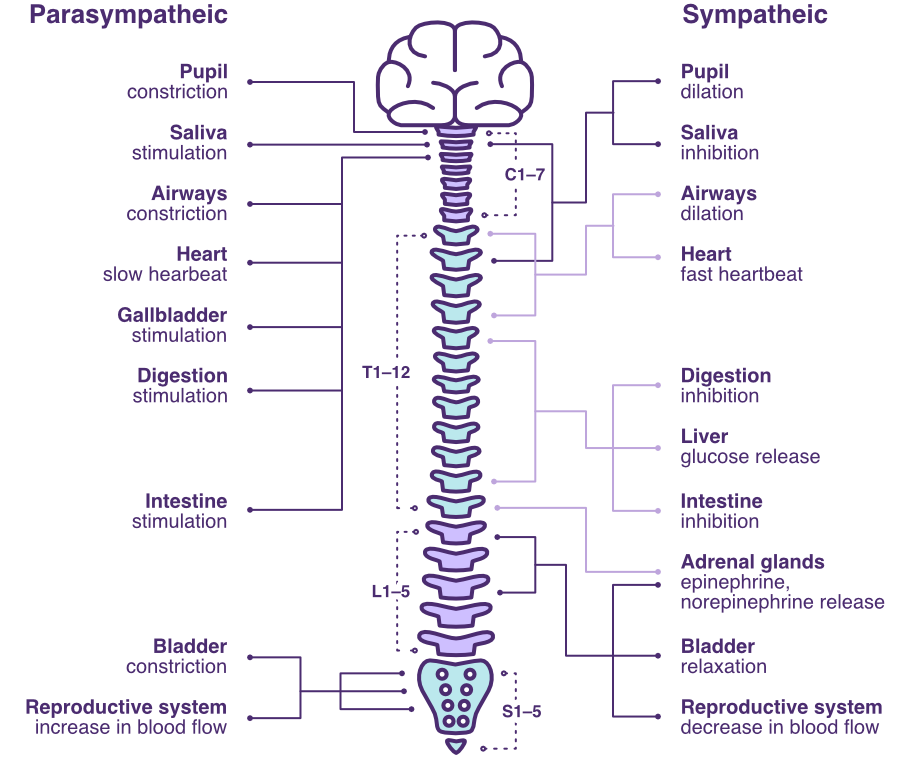Autonomic nervous system
Key functions
The autonomic nervous system (ANS) controls many of the body’s involuntary functions, such as heart rate, digestion, and breathing. These functions occur automatically, without conscious effort.
The sympathetic division of the autonomic nervous system originates from spinal cord segments T1 to L2, while the parasympathetic division arises from cranial nerves and sacral spinal segments S2–S4.
The ANS plays a central role in regulating:
- Heart function: Regulates heart rate, rhythm and cardiac output.
- Blood vessels: Regulates the dilation and constriction of blood vessels to maintain blood pressure and flow.
- Glands: Stimulates glands like the adrenal glands to release hormones, such as adrenaline.
- Smooth muscles: Manages the involuntary muscles found in organs such as the bladder, intestines, and airways.
- Internal organs (viscera): Oversees the functions of major organs.
Components of the autonomic nervous system
1. Sympathetic nervous system
Activated during the ‘fight or flight’ response, it prepares the body for action.
- The ‘fight‘ response includes:
- increased heart rate
- release of adrenaline
- constriction of blood vessels to direct blood to areas where it is needed most.
- The ‘flight‘ response includes:
- inhibition of certain functions, such as digestion and urination.
2. Parasympathetic nervous system
Often referred to as the ‘rest and digest’ system, it slows down body functions after stress and promotes rest, digestion, and energy conservation.
3. Enteric nervous system
Sometimes called the ‘second brain‘ due to its complexity, the enteric nervous system controls functions of the gastrointestinal system such as:
- gastrointestinal movements
- gastric acid secretion
- local blood flow
- gut hormone release
- interaction with the gut’s immune system.

Autonomic nervous system disruption
A spinal cord injury can disrupt the connection between the brain and autonomic pathways, leading to an imbalance in the autonomic nervous system. The effects of autonomic nervous system impairment depend on the level where damage to the spinal cord has occurred.
For example, the sympathetic nervous system originates in the thoracolumbar spinal cord (T1–L2). Spinal cord injuries at or above T6 can severely disrupt the sympathetic nervous system, impairing its function.
Autonomic nervous system disruption following spinal cord injury can lead to:
Autonomic dysreflexia: A medical emergency characterised by a sudden rise in systolic blood pressure.
Cardiac issues: Including arrhythmias (irregular heartbeats).
Low blood pressure: Known as systemic hypotension.
Respiratory problems: Such as bronchoconstriction (narrowing of the airways) and increased secretions in the lungs.
Bowel and bladder control: Loss of voluntary control over these functions.
Exaggerated reflexes: Uncontrolled responses to stimuli.
Sexual dysfunction: Problems with sexual health and function.
Temperature regulation issues: Difficulty maintaining normal body temperature.
Related content
Autonomic nervous system (Sympathetic and parasympathetic)
Dr Matt and Dr Mike
Sympathetic nervous system
Dr Matt and Dr Mike
Sympathetic nervous system
Crash Course
Autonomic Dysreflexia facilitator resource kit
Queensland Spinal Cord Injuries Service
Henke, A., Billington, Z., & Gater, D. (2022). Autonomic dysfunction and management after spinal cord injury: A narrative review. Journal of Personalized Medicine, 12(7), 1110. https://doi.org/10.3390/jpm12071110
Krassioukov, A., Stillman, M., & Beck, L. A. (2020). A primary care provider’s guide to autonomic dysfunction following spinal cord injury. Topics in Spinal Cord Injury Rehabilitation, 26(2), 123–127. https://doi.org/10.46292/sci2602-123
Wulf, M. J., & Tom, V. J. (2023). Consequences of spinal cord injury on the sympathetic nervous system. Frontiers in Cellular Neuroscience, 17, 999253. https://doi.org/10.3389/fncel.2023.999253